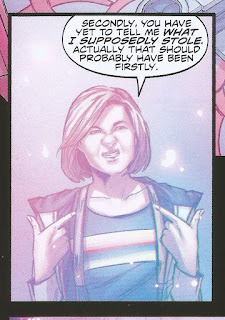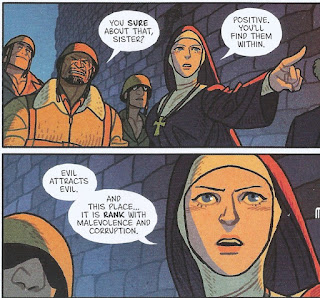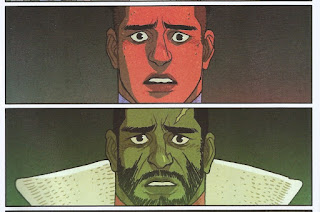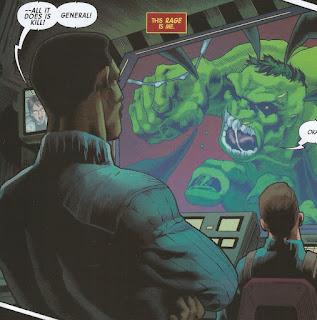Pick of the Brown Bag
June 19, 2019
by
Ray Tate
Happy 30th Anniversary
Happy 30th Anniversary
Welcome to the Pick of the Brown Bag, in this column I pick the best and the worst comic books of the week. For this edition, I look at Aquaman, Batman, Captain Marvel, Doctor Who, Gogor, Immortal Hulk, MegaGhost, Outer Darkness, Spider-Man and the League of Realms and Unstoppable Wasp. You can find these and other reviews in tiny form on Twitter: #PickoftheBrownBag
Nadia Van Pym escaped from the Red Room--birthplace of the Black Widow--to level the playing field of brilliance. She wanted to recognize female scientists.
To that end, she recruited girl geniuses. With Jarvis, Janet Van Dyne her newly adopted Stepmom and Bobbi Morse, newly appointed Mockingbird mentor, Nadia established the feminist think tank GIRL.
Unfortunately, when you do something cool, everybody wants to steal it. In this case, it's everyone's favorite beekeepers AIM, led by mad scientist Monica Rappaccini and chaperoned by her own anti-GIRL unit.
Monica's reveal comes unexpectedly. I must admit, I just thought she was in this for the pleasure of hurting Nadia, whom she crossed before. Alternately, I considered greed as her motive. The goal seems loftier than thought, but her execution sucks.
Rappaccini's partners in crime are easier to understand. AIM is in this for a paycheck, and that's why they will remain forever ineffective, until Stan Lee's and Jack Kirby's ghosts return to do them crazy justice.
Everybody in this story has a special dance partner. Bobbi and Bucky face trouble in Russia after being led into a trap. Former Avengers Academy hero Finesse turned villain and seeks a challenge.
Her nemesis Ying is another Red Room escapee who was Nadia's best friend and became her best friend again once her newly adopted girlfriend removed the bomb from her head. The Red Room also sucks.
That tech recently stolen by Rappaccini comes to the fore when Nadia faces a social media troll come to life.
This scene exemplifies some of the shocking things about Unstoppable Wasp. While the book can be read by all ages, writer Jeremy Whitley doesn't talk down to his audience. His whole underlying theme is about gender disparity. He celebrates actual female scientists at the end of each issue. Ying and Shay have a relationship. He masterfully addressed Nadia's inherited bipolar disorder.
The point is that Nadia loves putting "adorable beekeepers" in sleeper holds, but not every villain can be defeated so easily. Being a superhero demands the occasional knockabouts. Nadia like Batgirl chose a life of violent opposition. She needs to know she will eventually bleed. A fact artist Gurihiru provides in spades.
In another part of the story, Whitley readdresses David Cannon's obsession with Janet Van Dyne. He at once comes up with a plausible, lunatic world view and gives Janet her due. Wasp originally sought her identity for revenge. It's a moment where the stalked takes out the stalker. Wasp's history makes the moment credible and not simply providing a feel-good deus ex machina.
Nadia Van Pym escaped from the Red Room--birthplace of the Black Widow--to level the playing field of brilliance. She wanted to recognize female scientists.
To that end, she recruited girl geniuses. With Jarvis, Janet Van Dyne her newly adopted Stepmom and Bobbi Morse, newly appointed Mockingbird mentor, Nadia established the feminist think tank GIRL.
Unfortunately, when you do something cool, everybody wants to steal it. In this case, it's everyone's favorite beekeepers AIM, led by mad scientist Monica Rappaccini and chaperoned by her own anti-GIRL unit.
Monica's reveal comes unexpectedly. I must admit, I just thought she was in this for the pleasure of hurting Nadia, whom she crossed before. Alternately, I considered greed as her motive. The goal seems loftier than thought, but her execution sucks.
Rappaccini's partners in crime are easier to understand. AIM is in this for a paycheck, and that's why they will remain forever ineffective, until Stan Lee's and Jack Kirby's ghosts return to do them crazy justice.
Everybody in this story has a special dance partner. Bobbi and Bucky face trouble in Russia after being led into a trap. Former Avengers Academy hero Finesse turned villain and seeks a challenge.
Her nemesis Ying is another Red Room escapee who was Nadia's best friend and became her best friend again once her newly adopted girlfriend removed the bomb from her head. The Red Room also sucks.
That tech recently stolen by Rappaccini comes to the fore when Nadia faces a social media troll come to life.
This scene exemplifies some of the shocking things about Unstoppable Wasp. While the book can be read by all ages, writer Jeremy Whitley doesn't talk down to his audience. His whole underlying theme is about gender disparity. He celebrates actual female scientists at the end of each issue. Ying and Shay have a relationship. He masterfully addressed Nadia's inherited bipolar disorder.
The point is that Nadia loves putting "adorable beekeepers" in sleeper holds, but not every villain can be defeated so easily. Being a superhero demands the occasional knockabouts. Nadia like Batgirl chose a life of violent opposition. She needs to know she will eventually bleed. A fact artist Gurihiru provides in spades.
In another part of the story, Whitley readdresses David Cannon's obsession with Janet Van Dyne. He at once comes up with a plausible, lunatic world view and gives Janet her due. Wasp originally sought her identity for revenge. It's a moment where the stalked takes out the stalker. Wasp's history makes the moment credible and not simply providing a feel-good deus ex machina.
An angel named Fernande fell in love with another angel named Anemone. Wannabe despot of the universe, the Dark Elf Malekith convinces the Angel Realm to throw in with him. The alliance established, he asks if he can kill an Angel to see what it feels like.
Surprisingly the leader of the Angels agrees, and Anemone falls to his blade. Despite this blow, Fernande, possibly suffering from shock, remains loyal to the Angels and their Queen. She becomes the legate of Lagos on behalf of Malekith, that is until Spider-Man helps her rediscover the seething rage over her lost love.
Now Fernande fights alongside of Spidey and the League of the Realms.
The League didn't exactly have the faith that Thor has in Spider-Man. So they split. Some like the sorcerer Ro Bloodroot stuck with Spidey. Others such as Golden Elf Sir Honeyshot nipped off to fight the Dark Elf Legion. In this final issue of the War of the Realms tie-in, the League reunites to battle Kurse.
Kurse lives up to her name. Introduced in the Mighty Thor when Jane Foster wielded the hammer, Kurse is in fact a victim of Malekith’s treachery.
In this story, the Amazing Spider-Man once again lives up to my image of him. Free from the wight of confusing continuity, Spidey is a trained observer whose belief in redemption is intrinsic to his nature.
Malekith would have been smart to first kill Spider-Man before attacking the earth. Thor sees Spidey's courage and fairness. That's why he chose him to lead the League of the Realms.
The rapid release War of the Realms second issue of Captain Marvel concludes her team-up with Black Widow and Dr. Strange against the Enchantress.
The heroes first try to get used to working with each other’s strengths and weaknesses. Then they realize it’s their knowledge of themselves that will win them the day.
Meanwhile, and quite hilariously, Black Widow fights a wayward crocodile. Thereby almost stealing the book right from under Carol's nose. And mustache.
Jody Houser opens her multipart third Doctor Who story with a simple little getaway for the Doctor and her friends.
Of course the Doctor’s not going to get away with enjoying a quiet moment.
With Yaz using her law enforcement background to defend, the Doctor stands trial yet again. The evidence isn’t in her favor. Theft. Alien. Two hearts.
Amusingly, she hasn’t entirely dismissed that she’s guilty.
The Doctor is ready made to be accused of a crime. People like to forget that she stole a TARDIS and tampers with history in direct violation of Time Lord Law. She also in the past contravened inconsistent Time Lord laws such as bringing aliens to Gallifrey. The Doctor is in fact and repeatedly designated a rogue Time Lord.
The Doctor's reasoning behind her possible guilt is that perhaps in the future she steals the gem for all the right reasons. Given the description, she will have stolen it in a new incarnation. Still female. The problem is the Doctor thinks she knows who is really behind the theft, and she intends to let curiosity be her guide. Where that leads her is surprising.
The thief of the piece is mentioned in the television series. The rebellious alien is canonical, and Houser once again demonstrates a more than passing interest in the mythology of Doctor Who. I'm also happy to see artist Roberta Ingranata back for the ride along with Enrica Eren Angiolini she of the vibrant colors.
The Charon encounters a Haunted House in space.
The anomaly just hits you in the face, and there’s a better image of the entity within. Writer John Layman clues the reader into the history of the house. It’s excellent stuff tapped from the best of horror.
As Layman takes us through the lineage, he pitstops at an important moment in 1941.
I mean, you had me at Haunted House in Space. Adding a short story within the main story about Nazi Hunters in the Haunted House is cheating.
Artist Afu Chan demonstrates perfect timing with his cuts between the present, with respect to the crew of The Charon, and the past. In such a tale, you can easily fall into the trap of spending too much time in either period.
Chu and Layman use these shifts in time to enrich the reader’s understanding through visuals and judicious narration.
A long time ago Betty Ross was the Harpy. Then she became the Red Hulk. Nevertheless, still boring due to being an extension of Bruce Banner rather than a fully developed character. Al Ewing impressed me with a Betty focused issue of The Immortal Hulk, but lightning doesn’t strike twice.
Even when transformed, she’s still just so damn dull.
The Immortal Hulk is a remarkable feat of writing and art that overcomes the ennui miasma Betty Ross exudes.
Our tale opens with a memory from total sack of dicks General Fortean. He was a mere driver for the Rosses when he laid down some lousy science, with the hopes of sparking Betty.
In fact all three passengers in the car exhibit total ignorance about how the world works and the science behind it. This nicely characterizes the trio without tiresome exposition.
Betty’s naive. General Fortean even at this stage of the game is sick and twists the world to his liking. General Ross just doesn’t care and sees science as a necessary tool to make better war.
Ewing skips to the present day where Fortean watches his creation the new Abomination attempt to kill the Hulk.
Another example of body horror, the imagery in this issue is an unsettling grotesque that also serves the plot and the themes.
Fortean’s been scavenging gamma-irradiated individuals to build a monster that can counter the Hulk’s newer abilities.
The Hulk and Banner want to end humanity's reign over the planet earth. They both feel humankind screwed up this world but good. Hulk and Banner seem to be dedicated to genocide, though I'm sure the solution is more complex. Even so, you root for the creature.
The real monster is still Fortean who orders his soldiers to kill any civilians in the vicinity. The soldiers though are not innocent. Every soldier can disobey an order if she determines that order is illegal. Executing an innocent, unarmed civilian is murder. It doesn't get more illegal.
The real monster is still Fortean who orders his soldiers to kill any civilians in the vicinity. The soldiers though are not innocent. Every soldier can disobey an order if she determines that order is illegal. Executing an innocent, unarmed civilian is murder. It doesn't get more illegal.
What happens next in Immortal Hulk is startling and disturbing, especially when Al Ewing brings back the Big Guy. The Hulk everybody can recognize, in horrible, unimaginable dire straits.
Morgan Magnus gives her brother Martin the perfect birthday gift, an evening with the Gentleman Occultist, a new character in Megaghost named Franklin Arsenault. On the stage, Arsenault shows Martin a vision of the past.
Now you think you know where Megaghost heads, and some of it is true. This flashback issue introduces Arsenault's ancestor Emile, his assistant Miss Dumont and villain Madame Evangeline Desombres.
This is an entire new cast. So no spoilers, even though the build up to the debut seems to be shrouded in secrecy. The real surprise lies in the mystery passenger that hitches a ride with the Gentleman Occultist and Miss Dumont.
Soon, Desombres launches an attack, similar to the vision, that requires the intervention of Megaghost. Hanna-Barbara styled robot fisticuffs ensue in all coolness, and when we return to the present, things get weird.
Morgan Magnus gives her brother Martin the perfect birthday gift, an evening with the Gentleman Occultist, a new character in Megaghost named Franklin Arsenault. On the stage, Arsenault shows Martin a vision of the past.
Now you think you know where Megaghost heads, and some of it is true. This flashback issue introduces Arsenault's ancestor Emile, his assistant Miss Dumont and villain Madame Evangeline Desombres.
This is an entire new cast. So no spoilers, even though the build up to the debut seems to be shrouded in secrecy. The real surprise lies in the mystery passenger that hitches a ride with the Gentleman Occultist and Miss Dumont.
Soon, Desombres launches an attack, similar to the vision, that requires the intervention of Megaghost. Hanna-Barbara styled robot fisticuffs ensue in all coolness, and when we return to the present, things get weird.
A group of floating islands serve as the setting of a vivid, diverse population that’s a cross between the denizens found in the classic art book Wayne Barlowe’s Guide to Extraterrestrials and The Muppets.
Presumably human, Armano is a student. When insect-riding soldiers attack his school, he at the urging of his mentors escapes with a scroll vital to their survival. While making camp, Armano coincidentally meets Wexil, who translates the scroll. Armano reads the words and frees the title character Gogor.
Last issue ended with the introduction of Gogor. This issue is full on Gogor. A giant from the natural world who takes an immediate and riotous dislike for the bee riders.
He's more than brute strength. He exhibits a neat little breath weapon and surprising acrobatic ability. Manna for every fan of giant lizards with a soft spot for humanity.
Gogor is no golem. He does not blindly serve Armano. Armano seeks to free his school from the tyranny of the beekeepers. Gogor wants to head to the island of Bogwell Major. Not wanting to lose such a strong arm, Armano decides to accompany Gogor to Bogwell Major.
Bog. Well. Get it?
I’m very close to being done with Aquaman. The amnesiac story exhibited points of interest, and Robson Rocha’s artwork warranted viewing. Kelly Sue DeConnick’s new character Callie was inviting and probably can carry her own book.
This two part swim across memory lane is dragging me down. I also must ask why DeConnick felt such a need after the Aquaman movie did such a bang up job explaining Aquaman’s history to everybody.
DeConnick’s poor characterization of the Aquaman/Mera relationship makes me doubt any future entertainment value. Her explanation of Aquaman’s death and rebirth is filled with dubious twists. I’ll give her another issue to determine Aquaman’s fate on my subscription list.
How to review this book without any spoilers. When reading Batman, you’re deep into the main story that’s been going on for years without you even knowing it. On the other hand...
Tom King is very frustrating in this respect. Every now and again, he pops in and says, “Yeah, everything you’re reading may not be true.” If it’s not true, I have an idea about where, when and why the “dream” manifests. If true, I have questions. Lots and lots of questions.
So, what I can say about Batman is that the presence of a Thomas Wayne Batman from another universe seems more in keeping with Peter Tomasi, the master of Batman nuttiness. Tom King’s treatment is lyrical and layered almost devoid of the science fiction elements from which Thomas Wayne sprang. Pun intended.
The Powers That Be at DC didn’t create the idea of a parallel universe, but they ran with the concept for twenty years, establishing rules and protocols. The biggest one is that doppelgängers are not the same. Important differences in personality and growth distinguish them.
King argues that the incarnations bear more similarity than difference. For that reason Thomas Wayne is Bruce’s father. Even though not.
The idea of Thomas Wayne being Batman isn’t new. Before Flashpoint, in the nineteen fifties, Batman reopened the Wayne Murder Case and discovered a link between Joe Chill and gang boss Lew Moxon.
Thomas Wayne’s history with Moxon dates back to a fateful costume ball in which he disguised himself as a Bat. Batman will don his father’s costume to strike fear in Moxon. Another Thomas Wayne Batman also appeared in the New 52 title Earth 2.
The differences between this Thomas Wayne Batman and our Batman arise on the first page. The song becomes more recognizable as the trek continues.
He’s singing an American folk song and continues the ditty throughout the story.
Somewhere down the line I’ve lost the idea that Batman is an American. He lacks the obvious patriotism of Superman. He has no first hand grasp of American culture. Batman’s knowledge of music for example is probably encyclopedic, but only in reference to crime. For example, Batman likely knows about the history of the song Strange Fruit. Its soulful condemnation of racial lynching.
The Americanism of Batman furthermore belies the Django imagery.
In the original Django, our hero embodied by Franco Nero, is seen dragging around a coffin. What’s in that coffin helps make Django one of the best spaghetti westerns amidst a whole plateful. All the spaghetti westerns are supposed to be taking place in the American west of the 1800s, but rarely do you ever feel that. They always seem eerie outliers of history.
I'd be lying if I said that I knew exactly where Tom King piloted Batman. I cannot even determine the reality in the fiction. That doesn't make me want to stop reading. Unlike Scott Snyder's Justice League where I felt horribly confused, I feel when reading Batman certain that King has a plan. Even if I don't know what its is.







































